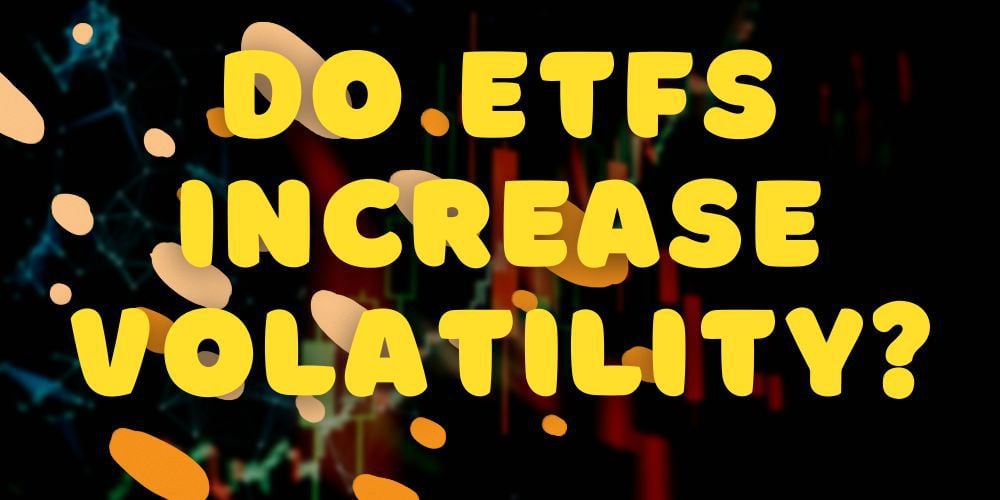ETFs are one of the best ways for traders to diversify their asset portfolio and reduce risk at a fairly low cost.
But, do ETFs increase volatility as well?
Truly speaking research has shown that stocks with high ETF ownership can have the unintended consequence of significantly higher volatility.
We explain why this happens below.
About ETFs
Exchange-traded funds (ETFs) are financial instruments that usually track a set of stocks or an entire index.
They allow traders to deal in a basket of securities without collecting individual stocks.
In this way, they are similar to mutual funds. However, these two have several differences.
For one thing, ETFs are traded on the stock market just like securities.

They can be bought or sought during market operating hours by both retail and institutional investors, and their prices change throughout the day.
Mutual funds can only be purchased from their creators, and their net asset values are decided only once during the day.
Moreover, ETFs usually have much lower expense ratios. This is because most of them passively track indexes.
On the other hand, most mutual funds have a team of fund managers who actively monitor and control their composition.
About Volatility
Volatility is a measure of how much a share price moves from its mean during a given period.
Analysts judge how much risk is present in a stock using this number. The higher the volatility, the more the risk.
There are two ways to judge this metric.
One way is using the standard deviation against the stock’s own price.
The other is to monitor its movement with respect to a market index or another share.
Do ETFs Increase Volatility?
Yes, research has established that ETFs increase volatility in their underlying securities through a very complex process.
Due to the nature of the ETF creation and redemption process, mispricing can sometimes happen between their market value and the NAV of the underlying shares.
This creates an arbitrage opportunity, which creates a chain of events leading to pricing pressure on the stocks that are part of the fund.

On balance, studies have proven that high ETF ownership increases stock volatility.
Let’s look at this process to understand why and how this happens.
How ETF Units Are Created & Redeemed
ETFs are one of the most liquid assets on the market. Their low trading costs and benefits have caused many retail investors to buy them.
Fund managers often have to create new units to meet excess demand in the market.
When this happens, they ask an authorized participant (AP) to arrange for the basket of underlying stocks that form part of the fund.
In exchange, ETF shares are awarded to the APs, who circulate them in the market.
This trade happens at the securities’ net asset value, not the fund’s market price.
Note this last point: this is what creates the problem.
Why ETF Arbitrage Happens
During the above process, it is possible that the price of the fund becomes different from the net asset value of its constituent portfolio of stocks.
The former is refreshed every 15 seconds.

But even this small time gap is enough for short-horizon liquidity traders to use the arbitrage arising from the mispricing.
For example, if the ETF share price becomes lower than the NAV of the underlying securities, they can short-sell the stocks and buy the fund.
How Arbitrage Increases Volatility
To close out the arbitrage, the net asset value of the shares and the fund’s price need to eventually match.
The trades we mentioned in the previous section create pressure on stock prices to move so that this gap is closed out.
Due to the high trading volumes of the ETF market, these trades make a strong enough push to cause the underlying stock prices to move.
Note that this process is not unique to ETFs.
Pricing arbitrage in any asset class that consists of a basket of securities (such as mutual funds) can create the same effect.
However, the difference is that ETFs are highly liquid and get bought or sold throughout the day.
Hence this entire process repeats several times, causing share prices to swing.
If you remember from the earlier sections – due to this constant movement, an increase in volatility appears in these securities.
The After Effect
A 2018 paper studied the impact of this process and uncovered several startling findings.
It showed that stocks with higher ETF ownership display significantly higher volatility.
There was a 3.4% impact on the metric for such shares.
Moreover, the study revealed that such ownership increases the negative autocorrelation in stock prices.

Let’s explain this a bit:
Autocorrelation is the dependence between two consecutive price events happening to the same share.
When it is positive, it implies that if the share rises once, its likelihood of rising in the next instance is higher.
On the other hand, if it is negative, the price has a higher probability of yo-yo-ing between gains and losses.
The research showed the second type of behavior was more probable in these securities.
Overall, the chain of events creates a significant risk premium for the share, despite no fault of its own.
Are ETFs More Volatile than Mutual Funds?
Yes, ETFs are more volatile. As mentioned, they are traded just like other shares on the market.
Hence their prices can change several times during the day.
On the other hand, mutual funds are not traded directly on stock markets.
Their net asset value is decided only once daily and does not change after that.
Do ETFs Perform Better than Mutual Funds?
Between a comparable index mutual fund and an ETF that tracks the same, it might be better to opt for the latter.
This is because exchange-traded funds have lower expense ratios and are more tax efficient.
However, most mutual funds are actively managed.
They might have the potential for higher returns due to the constant efforts of their management team.
Is It Better to Hold Stocks or ETFs?
Both ETFs and securities have their pros and cons.
Individual stocks might possibly offer higher capital appreciation, but ETF ownership is usually less risky.
Traders who understand and analyze stocks to make individual picks might prefer to deal with them.
ETFs are better suited for investors who may not have the time or knowledge to do this.
Do Most ETFs Fail?
While most ETFs do not fail, a significant number do.
ETFs are fairly low-margin products; they need a large portfolio to cover costs.
Hence products with a narrow band of stocks are always at risk of failure.
Sometimes, there may not be enough investor interest in the set of stocks that the ETF represents.
In all such cases, the fund might eventually have to close down.
Final Thoughts
ETFs are darlings of the stock market for several reasons.
They offer low cost of ownership, diversification, lesser risk, and liquidity for investors.
But research has shown that the huge ETF trading volume may have caused some unforeseen problems.
When traders leverage arbitrage in these funds, the liquidity shocks can propagate to the underlying stocks.
This process can lead to significantly higher volatility and introduce undiversifiable risk in prices.
Moreover, it raises the chance of a negative autocorrelation in shares, causing them to move up and down.
Perhaps, market regulators should consider these impacts and look for a solution.


 Tags:
Tags:










